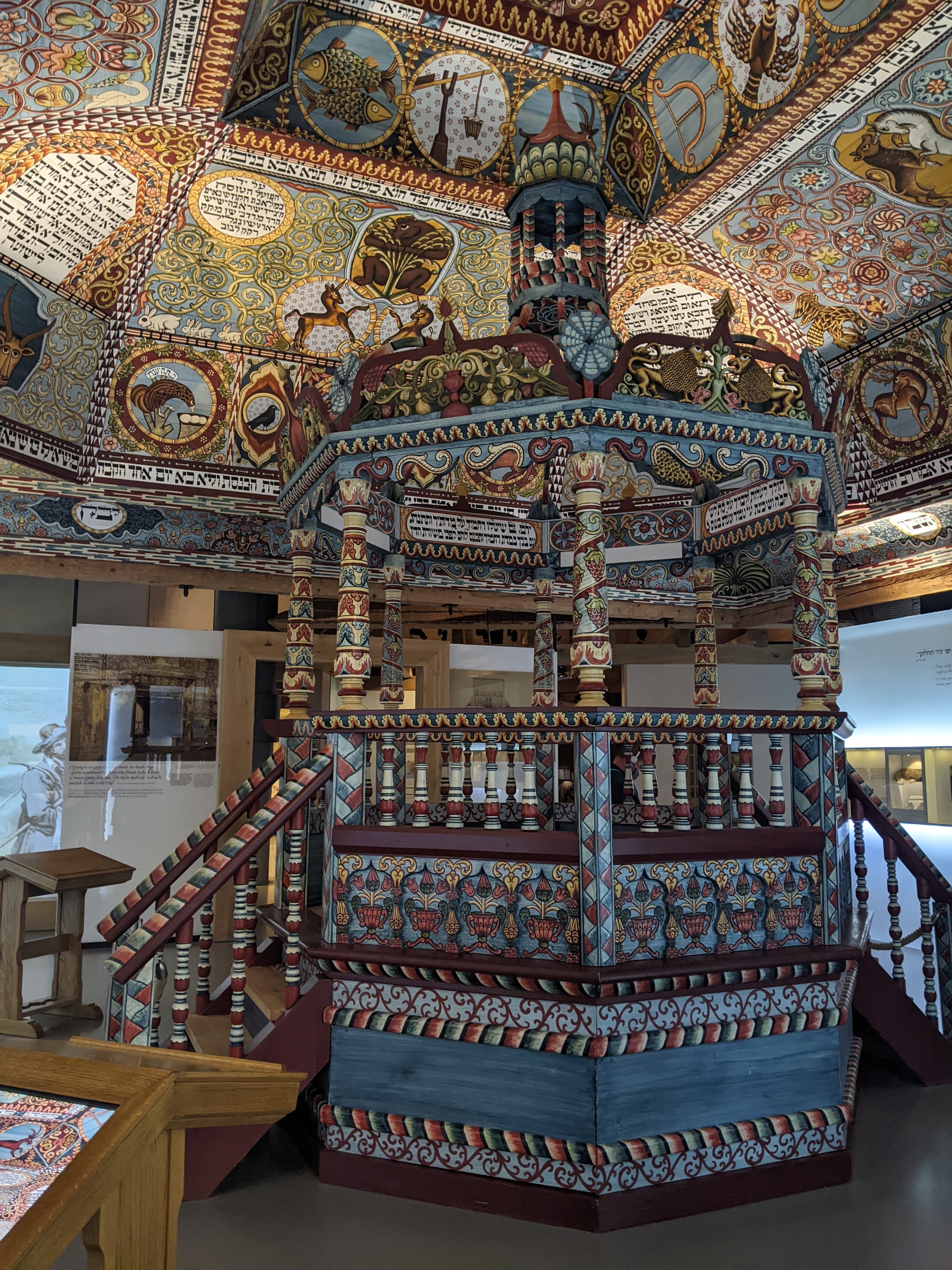-Annie, Jayne, Alexis, Ivy, Uma, Ben
Today, June 27th, was our first full day of activities in Warsaw, Poland. We started off our day at the Polin Museum where we took a tour through their exhibits. In the span of two hours, we traveled through 1,000 years of Jewish history in Poland.
As our guide told us, during the 16th, 17th, and early parts of the 18th century, Poland was a “Jewish paradise”, promising equal rights and freedoms under the law. To mirror this, the exhibit room was physically open, having information lining each wall with an interactive display in the center. Although it was a time of overall proseperity, there was still antisemitism. This was not a paradise as the word is defined “an ideal or idealistic state,” but rather a brief moment in time where life was a bit better than before, but still with hardship and hatred. Life changed dramatically after the Khmelnytsky Uprising in 1648, when peasants in Poland joined with Ukrainian forces who were rebelling against their nation’s nobility. In Poland, the peasants, who were displeased and disenfranchised by the feudal system, directed their anger at the jewish citizens of Poland; the peasants felt that the Jewish people were treated better than them, economically and socially. Pogroms and other acts of violence led to the death of thousands, and the relationship between Poles and Jews was changed forever.
A common theme that we noticed throughout the tour was the importance of identity in Jewish-Polish history. Some Polish-Jews identified as Polish before Jewish, and some identified as Jewish before Polish, indicating the relative importance of each of these identities to themselves. Furthermore, the language they spoke (Hebrew, Yiddish, Polish) and the clothing they wore influenced how they were perceived by the world as well as how they were perceived in their own communities. Even today, we learned that Polish Jews still struggle with this question of identity. We’ve noticed that people still refer to peoples as Poles and Jews, not Jewish-Poles or Polish-Jews, as if they are separate entities. However, times are beginning to change and many of the remaining Jews in Poland are starting to embrace their Polish heritage and identity.

Another theme that carried throughout the tour of the museum was how the culture and social norms of where the Jews were living influenced their views and practices within their own religion. The best example of this is in clothing. Although the Jewish people still had religious freedom, in the late 1700s more restrictions were placed on how they had to act and dress (this was occurring in many other countries such as Russia). As our guide explained, many of the Polish people believed that even if people were Jewish they should still follow the cultural norms of the area not of their religion. They were restricted on what types of clothing they could wear (long coats versus short coats) and could be fined if they were not following the set requirements. We noticed that this theme carried throughout many other aspects of the tour and of everyday life.
Later on in the day, after we finished lunch, we headed over to the Żydowski Cemetery, located just outside the former boundaries of the ghetto. This cemetery was colossal in size, so much so that one could not even begin to see the other side of it when we entered. This was an entirely Jewish cemetery that was created in the early 1800s. However, it was untouched by the Nazis during occupation. The cemetery contained many graves of those who had lived in the Warsaw Ghetto, and who had subsequently died there. While inside the cemetery, after a short introduction by Avi and Dr. Andy, our bus group divided into pairs and triplets and began to explore the hundreds of thousands of graves. We searched for symbols, occupations, names, and languages of the deceased on the tombstones. We were intrigued to find many of these, and discussed them with the group, learning how a three pronged candelabra represented the three patriarchs (Abraham, Issac, and Jacob), and that having the image of a pitcher pouring water meant that the grave belonged to a Levite. Afterwards, led by Avi, we went to a few specific places in the cemetery. One of these was a recently added memorial at the site of the mass grave of around 50,000 unknown Jews interned in the Warsaw Ghetto. This was memorialized by large rocks and distinct demarcations of the grave. We finished up our time at the cemetery at two last memorials, one which commemorated children who smuggled supplies to those inside the Warsaw Ghetto.
As a final stop for the day, we visited the Nożyk Synagogue, the oldest synagogue still in use in Warsaw that survived World War II. Inside, we listened to Natalia speak about the synagogue and its significance. We learned about her personal connection to the synagogue (her wedding and her son’s bar mitzvah both happened there) and admired its classic design. We were surprised that the only indication of its historical importance was a small sign on the facade of the building.
After finishing our trips for the day, we headed back to the hotel and later went to dinner at a local restaurant with the group. We ended the evening with a walk around Old Town, a calming and beautiful end to a very informative and impactful day.
